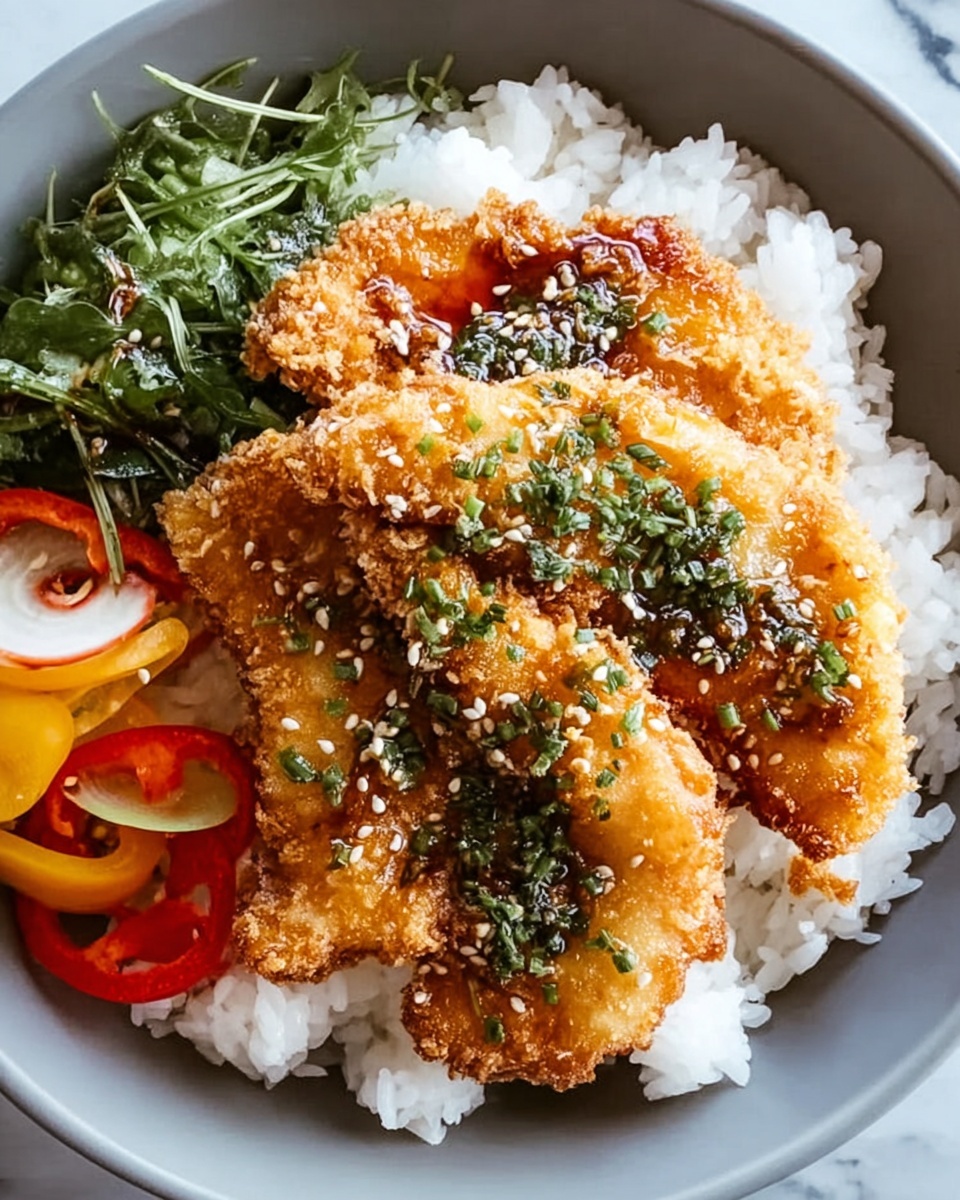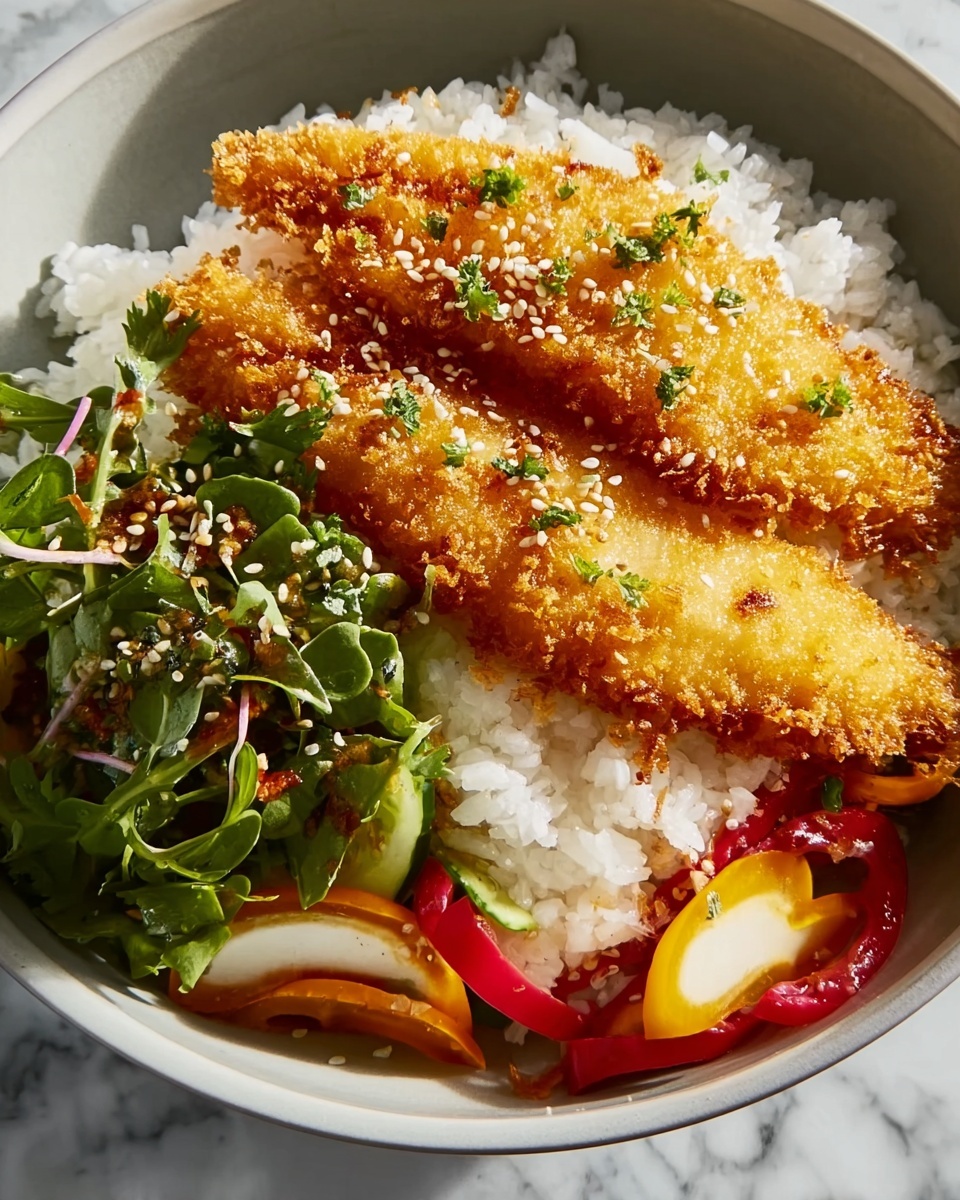If you’re craving something that bursts with texture and layered flavors, this Crispy Halibut Tempura with Japanese Pickles & Spring Onion Rice Recipe is here to delight your taste buds. Picture tender halibut fillets coated in a light, ultra-crispy tempura batter, paired with the refreshing tang of Japanese pickles and the fragrant, savory spring onion rice. It’s a perfect harmony of crunch, freshness, and umami all in one plate, making it a standout dish whether for a weeknight dinner or a special gathering.

Ingredients You’ll Need
This recipe shines because of its simplicity and balance, with each ingredient playing a vital role in creating those unforgettable flavors and textures. From the flaky halibut to the delicate tempura batter, and the vibrant spring onion rice to the bright, piquant Japanese pickles, every component is essential.
- 4 pieces Halibut fillets: Choose boneless pieces for easy eating and a satisfyingly flaky texture.
- 1 cup Flour: This helps the tempura batter stick perfectly to the fish for a crisp finish.
- 2 Eggs: Eggs add richness and help bind the batter for that signature light crunch.
- 1 cup Tempura batter mix: Using a specialized mix ensures a super-light and airy coating.
- 1 cup Spring onions: Finely chopped spring onions infuse the rice with fresh, mild onion flavor.
- 1 cup Japanese pickles: Their zesty tang cuts through the richness and brightens the entire dish.
- 2 cups Short-grain rice: The sticky and tender rice acts as a filling canvas for the dish.
- 2 cups Dashi stock: This savory broth enriches the rice with umami depth.
- Canola oil: Ideal for frying thanks to its neutral flavor and high smoke point.
- 1 tablespoon Soy sauce: Adds a splash of umami seasoning for the rice and pickles.
- Salt and white pepper: Adjust to taste to season both the batter and rice perfectly.
How to Make Crispy Halibut Tempura with Japanese Pickles & Spring Onion Rice Recipe
Step 1: Prepare the Rice
Start by rinsing the short-grain rice under cold water until the water runs clear to remove excess starch. Then, combine the rice and 2 cups of dashi stock in a pot and cook it gently until the rice absorbs all the liquid and is tender. Once cooked, fold in the finely chopped spring onions and a splash of soy sauce, seasoning with salt and white pepper to taste. This rice will be fragrant and savory with a subtle aromatic lift from the spring onions.
Step 2: Make the Tempura Batter
In a mixing bowl, whisk together the flour, eggs, and tempura batter mix with cold water (follow the batter mix instructions for liquid quantity). The key to perfect tempura batter is to keep it cold and avoid overmixing; a few lumps are just fine. This results in a light, crispy coating that doesn’t weigh down the delicate halibut fillets.
Step 3: Heat the Oil
Pour canola oil into a deep pan or fryer, filling about 3 inches deep. Heat the oil to around 350°F (175°C), ideal for achieving a golden crispy crust. Use a thermometer if you have one; if not, drop a little batter into the oil – it should sizzle and rise steadily without burning.
Step 4: Coat and Fry the Halibut
Lightly dust the halibut fillets with flour first to help the batter adhere. Then dip each piece into the tempura batter, fully coating them. Carefully lower the battered fillets into the hot oil, frying a few at a time without overcrowding. Fry until they’re a glorious golden brown, about 3-4 minutes, then drain on paper towels to keep them crisp.
Step 5: Prepare the Japanese Pickles
While the tempura fries, arrange the Japanese pickles on a small plate or bowl. These pickles add a bright, crisp acidity that contrasts beautifully with the richness of the fried halibut.
How to Serve Crispy Halibut Tempura with Japanese Pickles & Spring Onion Rice Recipe

Garnishes
To finish the dish, sprinkle finely chopped spring onions or a few sesame seeds over the tempura for an extra pop of color and flavor. A wedge of lemon on the side also brightens the crispy halibut, offering a zesty counterpoint that invites everyone to dig in happily.
Side Dishes
Serve this dish with a light miso soup or a simple seaweed salad for a well-rounded Japanese-inspired meal. The delicate soup and fresh salad complement the hearty texture of the tempura and the spring onion rice without overpowering them.
Creative Ways to Present
Try serving the crispy halibut tempura atop the spring onion rice in individual bowls, placing the pickles on the side for a clean and modern presentation. Alternatively, layer the rice in a bento box with the tempura pieces artfully arranged alongside the pickles for a picnic-worthy treat that’s as pleasing to the eye as it is to the palate.
Make Ahead and Storage
Storing Leftovers
If you have any leftovers, store the tempura and rice separately in airtight containers in the fridge. Keeping them apart prevents the batter from getting soggy and helps preserve the fresh flavors of the spring onion rice and pickles.
Freezing
While the tempura is best enjoyed fresh, you can freeze the cooked halibut before frying. Coat the fillets in batter, freeze them on a tray until firm, then transfer to a freezer bag. When ready to eat, fry from frozen, adjusting cooking time accordingly for a crispy finish even after freezing.
Reheating
To reheat, avoid microwaving the tempura as it will lose its crunch. Instead, reheat in a hot oven or toaster oven at 350°F (175°C) for 5-7 minutes to restore crispiness. The rice reheats beautifully in a microwave or on the stovetop with a sprinkle of water to keep it moist.
FAQs
Can I use other fish instead of halibut?
Absolutely! While halibut is ideal because of its firm, flaky texture, you can substitute with cod, haddock, or even basa. Just make sure the fillets are thick enough to hold together when frying.
How can I make the tempura batter lighter?
Use ice-cold water when mixing the batter, and mix just until combined—don’t overbeat. You can also add a splash of sparkling water to help create a lighter, airier texture.
Are Japanese pickles necessary for this recipe?
They provide a wonderful tangy contrast that balances the richness of the fried halibut and rice, but if you can’t find Japanese pickles, try substituting with a light cucumber or daikon pickle for a similar effect.
Can this dish be made gluten-free?
You can easily make it gluten-free by using a gluten-free tempura batter mix and gluten-free soy sauce. Just be sure the flour you use to dust the fish is also gluten-free.
How long does it take to prepare this dish?
This Crispy Halibut Tempura with Japanese Pickles & Spring Onion Rice Recipe takes about 15 minutes of prep time and 20 minutes of cook time, making it perfect for a relatively quick yet impressive meal.
Final Thoughts
This Crispy Halibut Tempura with Japanese Pickles & Spring Onion Rice Recipe truly brings something special to your dinner table, blending crisp textures with fresh and savory flavors that sing in harmony. Once you try it, you’ll want to make it over and over again to share with family and friends. So go ahead, dive in and enjoy every delightful bite!
Print
Crispy Halibut Tempura with Japanese Pickles & Spring Onion Rice Recipe
- Prep Time: 15 minutes
- Cook Time: 20 minutes
- Total Time: 35 minutes
- Yield: 4 servings
- Category: Main Course
- Method: Frying
- Cuisine: Japanese
Description
This Crispy Halibut Tempura with Japanese Pickles & Spring Onion Rice recipe offers a delightful fusion of textures and flavors. Crispy, light tempura-battered halibut fillets are paired with tangy Japanese pickles and fragrant spring onion rice cooked in savory dashi stock. Perfect for a refreshing yet hearty meal that showcases the best of Japanese-inspired cuisine.
Ingredients
Halibut Tempura
- 4 pieces Halibut fillets (boneless, flaky texture)
- 1 cup Flour (helps the batter adhere)
- 2 Eggs (essential for richness)
- 1 cup Tempura batter mix (ensures a light coating)
- Canola oil (for frying)
- Salt and white pepper (to taste)
Spring Onion Rice
- 2 cups Short-grain rice (filling base for dish)
- 2 cups Dashi stock (enhances savory flavor)
- 1 cup Spring onions (finely chopped)
Accompaniments
- 1 cup Japanese pickles (tangy complement)
- 1 tablespoon Soy sauce (adds umami)
Instructions
- Prepare the rice: Rinse the short-grain rice under cold water until the water runs clear. Combine the rice with 2 cups of dashi stock in a rice cooker or pot. Cook until tender and fluffy. Once cooked, gently fold in the finely chopped spring onions and season with salt to taste. Keep warm.
- Make the tempura batter: In a mixing bowl, whisk together the flour, tempura batter mix, and eggs with cold water (about 1 cup) until just combined. The batter should be slightly lumpy and cold to maintain crispiness.
- Prepare the halibut fillets: Pat dry the halibut fillets and season both sides lightly with salt and white pepper.
- Heat the oil: Pour canola oil into a deep frying pan to a depth of about 2 inches and heat to 350°F (175°C). The oil should be hot enough so that a small amount of batter sizzles immediately when dropped in.
- Fry the halibut: Dip each halibut fillet into the tempura batter, allowing excess batter to drip off. Carefully place the fillets into the hot oil. Fry for about 3-4 minutes per side or until the batter is golden brown and the fish is cooked through. Remove and drain on paper towels.
- Plate and serve: Spoon the spring onion rice onto plates, arrange the crispy halibut tempura on top or alongside, and garnish with Japanese pickles. Drizzle soy sauce lightly over the dish or serve it on the side for dipping.
Notes
- Use cold water for the tempura batter to help keep it crispy when fried.
- Ensure the oil temperature stays consistent to avoid greasy or soggy tempura.
- Japanese pickles add a refreshing tang that balances the richness of the fried fish.
- For extra flavor, you can add a sprinkle of toasted sesame seeds on the rice before serving.
- If you don’t have dashi stock, substitute with a light vegetable or chicken broth as an alternative.








